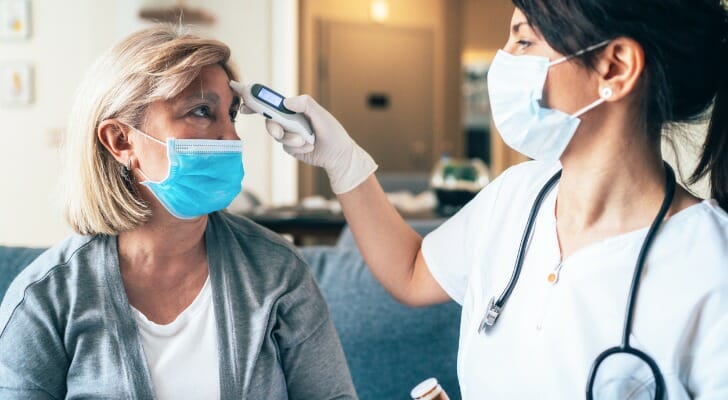 More than 1 million people in the U.S. have COVID-19, the disease caused by the novel coronavirus, and by the end of April nearly 60,000 Americans had died of the illness. The symptoms of some COVID-19 patients are mild and don’t require medical attention; others don’t experience any symptoms at all. But many people with the disease require serious medical care. Fortunately, the government has taken steps to minimize the financial impact on those who contract the illness. Here’s what’s available.
More than 1 million people in the U.S. have COVID-19, the disease caused by the novel coronavirus, and by the end of April nearly 60,000 Americans had died of the illness. The symptoms of some COVID-19 patients are mild and don’t require medical attention; others don’t experience any symptoms at all. But many people with the disease require serious medical care. Fortunately, the government has taken steps to minimize the financial impact on those who contract the illness. Here’s what’s available.
Help and Info From Government Agencies
Help is available from many federal agencies and departments. The Centers for Disease Control and Prevention offers a range of resources for people with the coronavirus disease. The Department of Veterans Affairs has a website explaining how it can help former military personnel. The Department of Health and Human Services provides information about how to access care via telehealth and find financial assistance. Other aids and answers can be found here.
Aside from these resources, Congress has passed two major bills to help people get through the pandemic. One is the Families First Coronavirus Response Act; the other is the CARES Act. Each entitles COVID-19 patients with various rights. Both contain valuable provisions for people with coronavirus disease.
What the Families First Coronavirus Response Act Offers
On March 18, 2020, Congress passed and the president signed into law the Families First Coronavirus Response Act (FFCRA). It mandates that employers provide paid sick or family leave benefits to employees affected by COVID-19. The act, enforced by the U.S. Department of Labor (DOL), expands upon the existing Family and Medical Leave Act (FMLA). The FFCRA includes three key provisions.
The first is that eligible employees receive up to two weeks (80 hours) of paid sick leave at their regular pay rate (capped by the CARES Act at $511 daily and $5,110 total) in circumstances where they cannot work or telework for one of three reasons:
- They are subject to a federal, state or local quarantine related to COVID-19.
- A health provider has advised them to self-quarantine because of COVID-19.
- They are experiencing COVID-19 symptoms and are seeking a medical diagnosis.
Secondly, the bill mandates that employees receive up to two weeks of paid sick time at two-thirds of their regular pay rate (capped by the CARES Act at $200 daily and $2,000 total) in circumstances where they cannot work or telework for one of these three reasons:
- They have to care for an individual subject to quarantine or self-quarantine.
- They have to care for a child (under 18 years of age) whose childcare provider is unavailable or school is closed, both due to coronavirus-related reasons.
- They are experiencing any other similar condition specified by the Secretary of Health and Human Services, in consultation with the Secretaries of Labor and Treasury.
Finally, the bill’s third provision mandates up to an additional 10 weeks of expanded family and medical leave at two-thirds the rate of the employee’s pay rate (capped at $200 daily and $10,000 total) if the employee cannot work because they need to care for a child whose school is closed or childcare provider can’t work for reasons related to COVID-19. The employee must have been working for 30 calendar days to be eligible.
The provisions are effective as of April 1, 2020, and will remain active through Dec. 31, 2020. Also, they apply to part-time workers, who are eligible for leave for the number of hours they normally would have been scheduled to work.
One thing to note is that the FFCRA is actually two provisions in one. It consists of the Emergency Paid Sick Leave Act (ESPLA) and the Emergency Family and Medical Leave Expansion Act (EFMLA).
Who Is Eligible for COVID-19 Paid Sick Leave?
The DOL deems all employees under “covered employers” eligible to receive the FFCRA’s paid leave benefits. But exactly which employers are covered? The bill’s guidelines apply to certain public employers, as well as private employers with 500 or fewer employees.
That said, companies with fewer than 50 employees may be exempted from paying sick leave to parents who must stay home to care for their children if the requirement would jeopardize the business. Also, many federal government employees aren’t covered by FMLA provisions, but they’re covered by Title II of the Family and Medical Leave Act. But the paid sick leave provision still applies to federal employees, according to the DOL.
Emergency Family and Medical Leave Expansion Act

As mentioned earlier, the FFCRA contains two acts. One of them is the Emergency Family and Medical Leave Expansion Act (EFMLEA). This expands upon the existing FMLA in several key ways.
During the time the FFCRA is active – from April 1, 2020 to Dec. 31, 2020 – the FMLA is expanded to include benefits for more people. Specifically, to be eligible for the additional 10 weeks of family and medical leave, you only have to have worked for the employer for 30 calendar days. Ordinarily, FMLA requires the employee to have worked for at least 12 months and to have clocked at least 1,250 hours of service for the employer during the 12-month period immediately preceding the leave.
Under these laws, an employee is entitled to up to 12 weeks of leave (the first two weeks unpaid or covered by ESPLA) for the purposes described in the EFMLEA: namely, taking care of a child whose school or place of care is closed or whose childcare provider is unavailable due to a public health emergency, in this case the COVID-19 crisis. Under this new law, though, and unlike the FMLA, the following ten weeks must be paid at two-thirds the employees’ regular rate of pay, up to $200 per day.
After this act expires at the end of 2020, the existing FMLA will not be impacted.
The Emergency Paid Sick Leave Act
The FFCRA’s other major act is the Emergency Paid Sick Leave Act. It EPSLA provides employees with up to two weeks of paid sick leave at their regular pay rate (up to $511 per day), when the employee is experiencing COVID-19 symptoms and is waiting for a diagnosis or is under quarantine (including self-quarantine advised by a health provider). It also provides up to two weeks at two-thirds the employee’s regular rate of pay (up to $200 per day) when the employee is unable to work or telework because of a bona fide need to care for a family member who is subject to quarantine.
On the other hand, the newly passed EFMLEA provides for up to an additional 10 weeks of paid expanded family and medical leave at two-thirds the employee’s regular rate of pay (up to $200 per day) where an employee is unable to work or telework due to a bona fide need for leave to care for a child whose school or childcare provider is closed or unavailable for reasons related to COVID-19. So after taking two weeks of paid leave under FFCRA, a parent can take an additional 10 weeks of paid leave – all at two-thirds their regular pay rate (up to $200 per day or $12,000 total for the 12 weeks). Before the FMLA was amended, the 12 weeks of leave were unpaid.
What the CARES Act Offers
On March 27, 2020, Congress passed and the president signed into law the Coronavirus Aid, Relief, and Economic Security (CARES) Act. Among its many provisions are several that offer help to people physically affected by the coronavirus.
- Free Coronavirus Testing
If you are uninsured, have Medicaid, or use military or Native American health systems, you may qualify for free coronavirus testing. If you have private health insurance, you may qualify for free testing as well. This cost can include the cost of an emergency room or clinic visit. The CARE Act also entitles you to a free vaccine at such a time as it is developed.
- Emergency Paid Sick Leave
If you work for a business with fewer than 500 employees, you may be eligible for paid leave due to the coronavirus. You may receive up to two weeks of paid sick leave if you or a family member contract COVID-19. You may also receive up to an extra 10 weeks of paid time off if your children are out of school or no daycare is available.
This portion of the bill may also provide a tax credit for businesses and self-employed individuals who need to cover the costs for paid time-off due to sick leave.
- Emergency Paid Leave
If you or a family member must quarantine or your child’s school is closed, you might be eligible for paid leave of up to three months. If you work for the government or a company with fewer than 500 employees, you may qualify for leave.
The Private Sector
Faith-based organizations, like Catholic Charities and major Jewish groups, bring considerable financial resources and experience to the challenges of COVID-19. Some of what these groups do is in coordination with federal, state and local governments, according to the HHS Center for Faith and Opportunity Initiatives. COVID-19 patients who reach out to faith-based groups can often find valuable, no-strings-attached support.
Corporate America has also responded to the COVID-19 challenge. Health insurance companies offer various free and discounted services. The pharmaceutical industry discounts some medicines. Physicians and hospital trade groups are pursuing similar patient-based initiatives.
The Bottom Line

The Families First Coronavirus Response Act and the CARES Act complement an array of resources provided by numerous federal agencies and departments. By using them patients can get emergency paid leave, emergency paid sick leave, free coronavirus testing, unemployment help and food aid. Besides availing yourself of the help these acts offer, consider getting help from the private sector. Finally, it’s wise to cut expenses, take care of yourself emotionally and make sure you have all the facts.
Tips for Finding COVID-19 Help
- A financial advisor can build you a financial plan that takes into account medical expenses and other unforeseen costs. Finding the right financial advisor who fits your needs doesn’t have to be hard. SmartAsset’s free tool matches you with financial advisors in your area in five minutes. If you’re ready to be matched with local advisors who will help you achieve your financial goals, get started now.
- Americans also stand to benefit from various coronavirus relief for rent and mortgage payments. And don’t forget to collect your coronavirus stimulus check. Use our coronavirus stimulus check calculator to see how much money you can expect to receive.
Photo credit: ©iStock.com/blackdovfx, ©iStock.com/filadendron, ©iStock.com/zoranm